What is a Scope of Accreditation?
What is a Scope of Accreditation?
A scope of accreditation is the official and detailed statement of activities the laboratory is accredited for. In essence, it is a formal list of tests and/or calibrations that your laboratory is accredited to perform.
When you are looking to become accredited to ISO/IEC 17025, the scope is a critical part of this process – much more detailed than Scope requirements in other ISO Management System Standards (like ISO 9001). Many laboratories forget about the importance of defining their scope when getting accredited or re-accredited. Rather than careful consideration, organizations will often quickly put their scope together and submit it to the accreditation body without thoroughly considering what activities they want to be accredited to perform. When defining your scope, you should consider what is functional for both you and your customers.
In essence, the scope of accreditation serves two purposes:
- To define the specific areas the laboratory’s activities that are to be covered the the accreditation
- To provide the user of an accredited laboratory with a clear idea of the specific calibrations covered by the accreditation.
Flexibility of Scope
Organizations need to consider the level of detail included within the scope of accreditation to ensure that there is an empirical balance between the amount of information needed by users of the accredited laboratory and the flexibility on the part of accredited laboratories to offer their services within appropriate scopes of their recognized competence.
If your scope is too detailed this can result in unnecessary demands for constant changes in scopes of accreditation. In return this can cause process delays and unwarranted restriction of competent services to laboratory users. On the other hand, when there is too little detail this can result in a laboratory offering accredited calibration service in an area of which it can not be assessed.
When you are trying to find the balance between the detail and flexibility of your scope, you should consider the organization’s ability to update or modify generic methods, or to implement new methods.
How to Create A Scope Of Accreditation
Follow the five step process listed below to develop your laboratory scope:
- Contact your Accreditation Body and get the draft template.
- Read your Accreditation Body’s policies and requirements.
- Research other laboratory scopes with similar capabilities.
- Enter your data into the Scope of Accreditation template.
- Submit it to your accreditation body with your application.
When you create your scope, the form should include:
- Name,
- Location,
- Technical or Quality Manager,
- Contact information,
- Certificate number,
- Expiration date, and
- List of accredited activities.
Many laboratories use their scope to attract potential and future customers, and if you plan to do the same it is important that you keep your scope up-to-date.
Testing Labs vs Calibration Labs
For Testing Laboratories the scope must include the tests or types of tests performed and materials or products tested and, when necessary, which methods used. For Calibration Laboratories the scope must include the calibrations, encompassing the types of measurements performed, the Calibration and Measurement Capability (CMC) or equivalent.
In general, most testing laboratory scopes of accreditation do not include statements or estimates of measurement uncertainty; making it challenging for customers to compare the capability and quality of testing laboratories. In this industry, the scope of accreditation should allow customers to confidently find and select a laboratory that will meet their requirements and provide reassurance. That is why working with a laboratory that is accredited to ISO/IEC 17025 is ideal.
Below, you will find testing and calibration labs and their parameters. Please expand each tab for more information.
Testing Areas and Parameters
The following are examples of parameters within each testing area. Check those testing parameters for which your laboratory is seeking accreditation. If you do not see your parameter, check “other” and specify in the space provided. This document is used in conjunction with the draft scope of accreditation above.
Acoustics and vibration
Biological/microbiological
Pharmaceutical/nutraceutical
Biotechnology/biochemical
Chemical
Animal drug testing
Paint
Fasteners
Fertilizers
Metals
Solvents
Inorganics/organics
Coal
Other-specify:
Construction materials
Dimensional inspection/measurement
Electrical
Environmental
Air
Asbestos
Environmental lead
Water
Bioassay
Radon
Underground storage
Solid/hazardous wastes
Other
Mechanical
Fasteners and metals
Paint
Plastics
Rubber
Windows and doors
Paper
Other
Non-destructive
Optical/photometric/radiometric:
Ionizing radiation
Thermal
Multi-disciplinary
Information technology
Medical/veterinary
Forensic
Occupational
Health/hygiene
Food/beverage
Calibration/Measurement Areas and Parameters
The following are examples of parameters within each calibration area. Check the calibration parameters for which your laboratory is seeking accreditation. If you do not see your parameter, check “other” and specify in the space provided. This document is used in conjunction with the draft scope of accreditation above.
Dimensional
Angularity
Gage blocks
Hand tools (mics, calipers)
Step gages
Measuring wires
Laser frequency/wavelength
UMM/bench micrometers
Roundness
Surface texture
Optical reference planes
OD cylindrical diameter
ID cylindrical diameter
CMMs
Threaded product
Height gages
Surface plates
Radius gages
Indicators
LVDT
Microscopes
Video/optical measuring machines
Other
Mechanical
Air speed
Flow rate (air or liquid)
Hydrometers
Mass
Volume
Force
Density
Ultrasonic reference block
Ultrasonic transducer
Vibration
Torque
Pressure/vacuum
Hardness testers
Acoustics
Scales and balances
Pipettes
Other
Thermodynamic
Humidity
Thermometry
IR thermometry
Thermocouples/pyrometer indicators
Other
Electromagnetic – DC/Low Frequency
DC voltage
AC voltage
DC current
AC current
Resistance
Capacitance
Inductance
Voltage/current converters (to 1 Mhz)
Current transformers
High voltage resistors
LF power/energy
magnetic
mixed dividers
phase meters
power-frequency
DMMs
pulse waveform
Resistance dividers
Oscilloscopes
Voltage transformers
Calibrators
RTD/thermocouples
Other
Electromagnetic – RF/Microwave
RF power
Attenuation
Phase
Amplitude modulation
Frequency modulation
Distortion
Harmonics
Electromagnetic field strength
HF capacitance
HF inductance
Q-standards
Reflection
Transmission
SWR
Other
Time and Frequency
Frequency/time (source/measure)
Time dissemination
Timers and stopwatches
Other
Ionizing Radiation
Dosimetry
Radioactive sources
Other-specify:
Chemical Quantities
PH
Conductivity
Viscosity
Refractometry
Other
Optical Radiation
Laser power energy
Photometric
Radiometric
Spectrophotometric
Wavelength
UV radiometric-standard detectors
UV radiometric-standard source
Attenuation
Other


